Once you have everything you need, you can start raising chickens very easily. As long as they are safe and their coop and run is kept pretty clean, you basically make sure they are fed in the morning, fed in the evening, and the door is shut at dark. Yes, there are more details, but don’t get too bogged down. You can totally raise chickens!
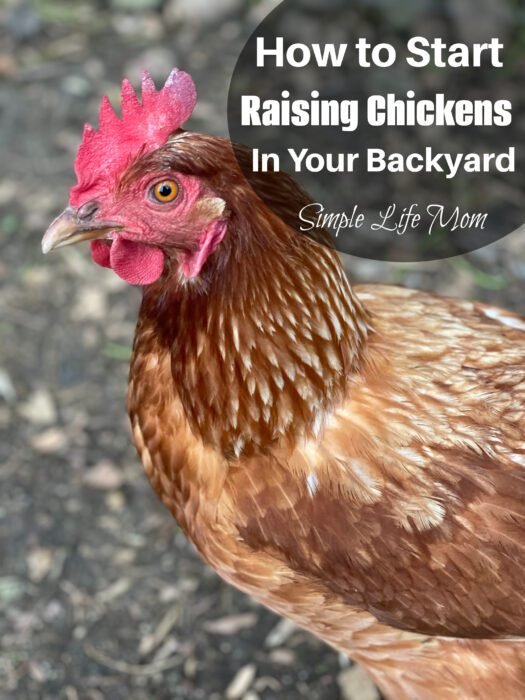
How We Got Started Raising Chickens
We’ve had chickens in our backyard for many years now. We actually started with ducks and rabbits, then added chickens to the mix. It was one of those things where I said, “Hey, I want ducks” and then went and got some without much knowledge or preparation. After all, I figured I could learn while they were growing indoors for the their first weeks.
I then picked up 4 chicks from Tractor Supply. Just so you know, Tractor Supply employees, as a rule, don’t know anything about chickens. I laugh about this now, but when I picked up the chicks, the employee told me he thought that they were all girls because they were the ones that ran when he put his hand in the bin. The ones that stood there seemed to be boys, because roosters would face you down, right? Well, James was wrong. Our first four chickens started facing off to one another, chest bumping, and then ALL FOUR started crowing! They were sweet at first, I had already gotten four more girls (sexed this time) and tried to keep the boys around. One by one they became terrors. Time for more learning!
We butchered two of the roosters. You can’t be queasy or mad about butchering if you are interested in raising farm animals. It’s part of it sometimes, even when you have hens. Of course, there are plenty of places to do it for you these days. That’s not the kind of gal I am though, so when we got ready, I got the job done. I cut open a milk jug on the bottom and then cut the top open wide enough for a head to come through. I nailed it to a fence post with the top side down. I won’t go into details, although it is a hilarious and kind of gruesome story. A lot was learned!
Since then I’ve butchered and fully processed for the freezer at least one hundred meat chickens and a few more roosters all by myself. More than anything, I wanted to learn how and know that I could if I needed to.
Eventually, we had to get rid of all of our original roosters. I had a duck I needed to care for daily and every time I got down I had to worry about getting jumped from behind. It made me a nervous wreck. So no more roosters….Until Spinach Dip. Yes, that’s the name of our fluffy, black, Silky. He takes his rooster job very seriously, but is the biggest sweetheart to us. I couldn’t be happier. If you want a rooster in your flock, I highly recommend silkies. They can be as dumb as a daffodil, but good with the girls and you.
Now, we have 22 birds. We’ve never lost one to a hawk. We trained our lab to chase any large bird that comes near our yard. I think she even barks at planes now, but it works. Plus we’ve taken other precautions for safety.
Lets dive in to the basics so you can feel confident to get started yourself.
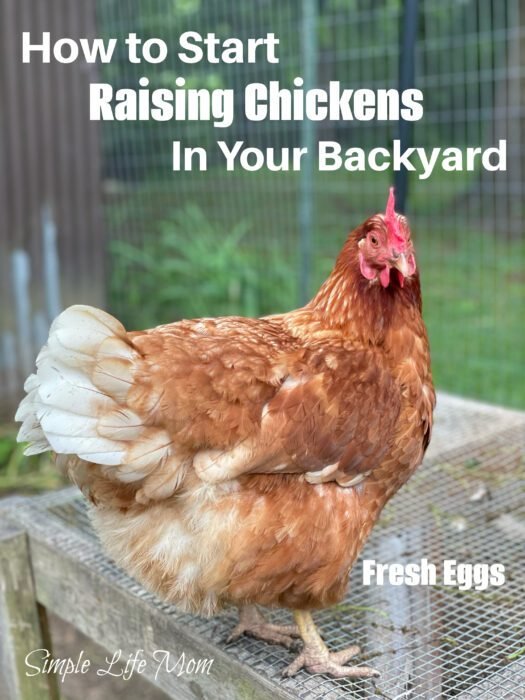
Before You Start Raising Chickens
Like I said above, I’m a dive in head first kind of person rather than prepare before I start, but there are some important things you need to consider before you take the dive.
1. Are You Allowed Chickens?
In some locations, housing developments or counties forbid backyard chickens. It is overbearing and ridiculous, but it happens. Some areas just forbid roosters, which I can understand, though why them and not dogs when dogs make a ton more noise?
So, make sure before you get everything ready and get those birds.
2. Do You Have Space?
Birds need space, though not a ton. I just drove near Knoxville, Tennessee and I couldn’t get over how many houses (some extremely large and fancy) had backyard chickens! It was marvelous! As long as you have a backyard where you can give them a safe place away from the weather and space to run around a bit, then you are set.
The rule of thumb is 4 square feet per chicken in a run, unless they are able to free range around the yard. If they are going to be able to run around the yard, then the coop space can be smaller. Enough room for them to be in there and move around comfortably in bad weather and roost safely. More on this below.
3. Do You Have the Money?
It does cost a little bit to get started, more or less depending on your property. It also costs money to feed them (or supplement food, if they free range only). You’ll feed and care for them for months before they start producing eggs for you. Keep this in mind. The trade off, of course, is that you will have the freshest and healthiest eggs available. You can even sell the extras around your neighborhood. They’re also really cute, and even my boys feel like they are our backyard pets.
4. Do You Have A Fence?
This isn’t a necessity if you are very rural, but we only have a few houses on our road and our chickens would STILL find their way into someone else’s yard up the street. I’d get a call tell me that my chickens were in their yard. They didn’t seem to mind, but sometimes they were dumb and wouldn’t go in their coop at night and we’d have to round them up. It was ridiculous. A lot of people in rural areas have no problems at all though.
We’ve now fenced in our backyard, which is a few acres, so all of the animals (including the dog) can run around and we don’t have to keep looking out the window to see if they wondered off or see the pekins walking right up the center of the road and quacking at our neighbor’s truck as it’s trying to get by them.
So, analyze your space. What do you have (fence, shed that can be converted, etc)? What do you need?
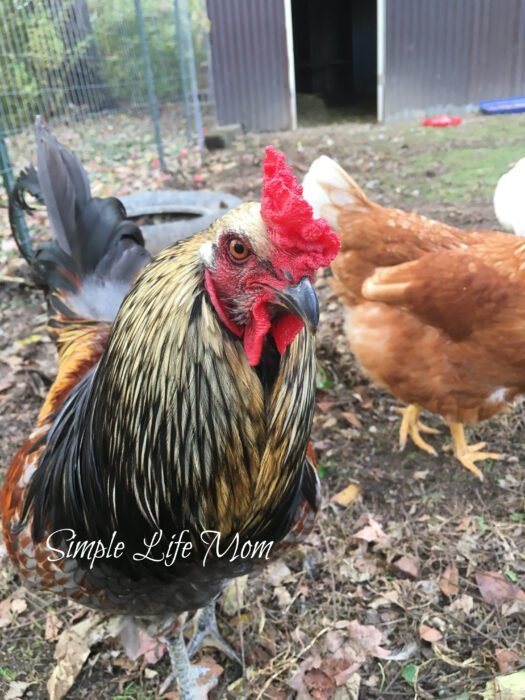
A Great Resource
Liz, from The Cape Coop, just published a book called, Keeping Backyard Chickens for Fresh Eggs & Fun. It is over 200 pages of information on:
- choosing the right breeds for your climate & lifestyle
- chicken keeping basics – how much time, money, & space you’ll need
- designing a chicken coop & enclosure that will make it easy to enjoy your flock & make chicken chores quick
- understanding the unique anatomy of your birds
- raising healthy chicks
- how to add to your flock over time
- navigating feed options
- dealing with & treating common illnesses and issues
- practical daily life with your flock: seasonal chicken keeping, dealing with aging hens, how to take vacations, neighbor concerns, keeping rodents out, and so much more!
So, while my guide here will give you a lot of basic information, if you want to dive deep and have something that covers more of the topics above, then please check out her book. It’s wonderful.
The Chicken Coop
You don’t need to buy a pretty chicken coop, but you do need an enclosed space to keep your chickens safe from bad weather and predators.
We converted an old shed on the corner of our yard into our coop. It was (is) an ugly thing, but they are warm and safe and that’s really all that matters.
If you buy a chicken coop ready to go like this one, then there is usually already a roost and nesting area available. The information below can be used to make sure you get/build the right kind of coop.
If you are building your own or converting a shed, then use the information below as a guide. Remember that people do things very differently and swear by their own methods, but these are what I’ve found that my birds love and thrive with.
Chicken Coop Size
We have 22 chickens/ducks in a 10x12ft shed that we’ve added insulation, roosts, and nesting boxes to. They have more footage in levels though. The ducks stay on the ground. The older chickens on the first roosting bars up about 3 feet. The youngest chickens all fly to the rafters (Except our silky rooster. He can’t fly up to join them.). So if you’re considering square footage, keep in mind that they all need to be able to be on the ground comfortably, but that upper footage counts as well.
Recommendations are 2 square feet per chicken if they are mostly out in the yard or run. If you have an enclosed space that doubles as a coop and run where they will always remain inside, then the typical recommendation is 4 square feet per chicken.
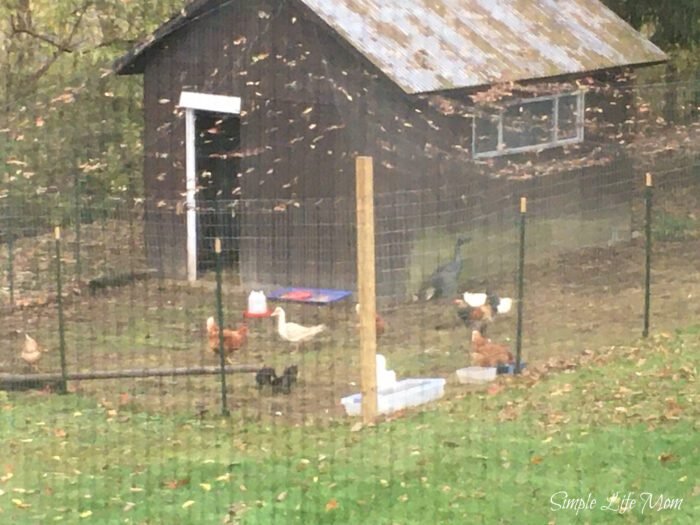
Roosts
Roosts are where chickens sleep at night. They like to be up off of the ground, some breeds like to be higher than others.
Silkies prefer a lower roost, while a lot of other birds will sleep in the rafters if you have them. If you ever can’t find one of your chickens at night when you’re closing the door, look up and you may find them in the highest spot.
2-3 inch wide beams are fine to put from one wall to the other, starting 3 feet off of the ground. This size allows them to get up off of the ground, grab on nicely with their feet, and poop onto the ground where it’s easy for you to clean. Ours would fly there, then to the higher window sill, then to the rafters. All of our new chickens sleep in the rafters. We have a few metal sheets up there between rafters so they have a loft, basically. Thankfully, only one tries to lay her eggs up there. my son looks for her eggs every other day. We didn’t even know they were there until we found an egg broken on the ground in the middle of the coop each day for a few days and then figured out what was going on.
Nesting Boxes
Nesting boxes are nests for chickens to lay their eggs. Chickens life fresh, clean hay or a similar material to make their nests in. We put up plastic bins onto the walls, 2 feet high. They are about 2ft x 1ft bins. They did not use them until recently though because our ducks were already laying on the ground so they copied them and layed in the duck nests. Now that our ducks aren’t laying as often and our younger birds are inexperienced, they FINALLY started using the nesting boxes.
If you are making your own nesting box, they usually like a 12inx12in space that they can get into and feel safe about 2 feet off of the ground.
The typical recommendation is 1 nesting box per 4 chickens. They will be upset and peck at the chicken in the nest if there are no other spaces. Sometimes they do anyway because they like that spot for themselves, but they’ll work it out.
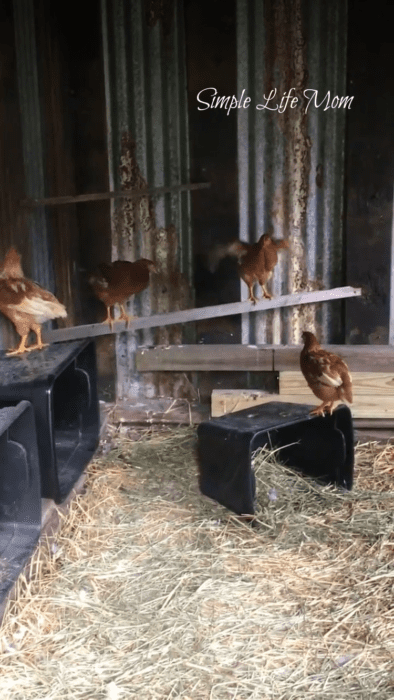
The Coop Floor
This is an important decision, but not one that you can’t change if you don’t like the method you are using.
Some people use sand in the coop. Each morning they scrape off any poop that’s up high and rake out the poop from the sand. I will say right now that I do not use this method because it’s a lot of work and sand can be expensive, depending on where you live and what your resources are.
I use the deep hay method. I have a dirt floor. If you have a wooden floor, then I recommend that you lay some linoleum over the wood to keep it dry and prevent rot. Since mine is dirt, I just put a couple of bales of hay in the corner, open one and spread some of it all over the coop. I daily check to make sure the areas under where they sleep is not “poopy”. They poop while they sleep so those are the areas it will build up. I’ll then take a shovel, scatter the poop, and sprinkle more hay on top (don’t forget to scrape off windowsills and check that the nests and roosts are clean). I only have to add more hay once every week or so, because sometimes I can turn the hay and that’s all that’s needed.
The deep hay method is also great for if you get water in the coop. Add more hay and it helps the area to not get muddy and dry out pretty quickly.
I rake out all of the hay twice a year. Once in the Spring and once in the Fall right before cold weather hits. I add this to my compost. It doesn’t build up very high actually, since it composts itself in the coop throughout the year. A local farm probably has hay that you can buy or that they’ll even give you occasionally.
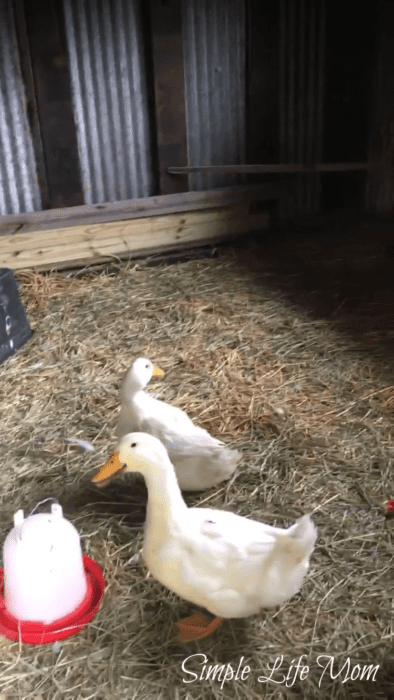
Dealing with the Winter Cold
The insulation was added more recently when we knew temperatures were going to be below zero. We have an oil heater like this one on a cement block out there during the winter, but it doesn’t do much when it gets that cold. They do fine down to the 20s, but they seem to really feel the cold in the teens and below. I know people who do nothing to heat their coops (no insulation or heater, just wood or metal sheets for walls) and their chickens get frost bite and they just shrug. I can’t stand to think that they were so cold that their combs got frost bite though, so ours get the insulation AND a heater for the super cold temperatures.
Dealing with the Summer Heat
Chickens will dust bathe, drink water, and find shade in the summer, so we’ll talk about providing these things in the section below on the Chicken Run.
Electricity? Small Door?
Do you need electricity? If you want a light for evenings or to power an oil heater, it’s something to consider. We used an extension cord before my husband ran electricity to the coop. But it’s not really a necessity.
We don’t have a small chicken door on our shed door. I wish we did and it’s something we will do when we replace the door. The door is wooden and has warped badly over the years and will need replacing soon. The reason I would like a chicken door is for cold temperatures. Leaving the door open a crack for them to get in and out still lets out so much more heat than if we had a small door.
The Chicken Run
A chicken run is a location for them to run around safely. It’s larger than the coop, open to the weather, and has a roof of some sorts to keep out predators. Not all people have a chicken run. They have a coop and a fenced in yard and that’s it. Even if that is going to be your set up, I still think a run is wonderful for two reasons. When you see hawks circling you can put them in there and know they can still run around without being cooped up (literally). Also, when you’re leaving and don’t want them wandering around, leaving the yard, or don’t want to worry about hawks when you’re gone, then a run is great to have.
My boys built my run. It looks a bit haphazard, but it works wonderfully. It’s tall enough that we don’t have to duck, and it’s covered so that we know hawks can’t get in. We had river rock around the house when we bought the property in locations that I wanted to convert to gardens, so we moved those rocks around the run fence so that nothing can easily get under and the rabbits running around the run with the chickens can’t easily get out.
Dust Baths
My chickens are mostly running around the yard in all weather and all seasons. They dust bathe in my flower garden where they uproot all of my smaller flowers, and under our trampoline, which is fine. Ideally, though, you’d like to provide a location for them to dust bathe in the run. We put a tire in the run and filled it with dirt and sand. I also added some Diatomaceous Earth to keep parasites down.
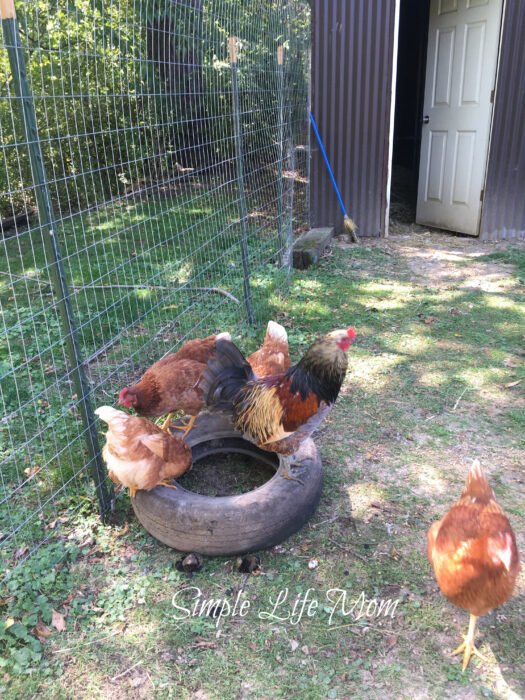
Roosts
Feel free to be creative and add things to your chicken run for them to fly up onto or walk under. We have an old rabbit hutch, rabbit hutches in use, a few logs, etc. They run from the rooster, get away from a pecking hen or an irritated duck. It’s not a must, but they enjoy it.
The Chicken Feed
Feed
Chickens are typically given “starter feed” for about 4-1/2 months. This has more protein (20-24%), plus a balance of nutrients for them as they grow. I do NOT get medicated feed. From my research, I don’t think it’s necessary or healthy.
After they start laying eggs or around 4-1/2 months you can switch to “layer feed”. This feed has 16-18% protein and often calcium.
Feed Amounts
A typical amount of feed per chicken is 4-6 ounces per chicken per day. So, if you have 6 chickens, you may put out 1-1/2 cups of food in the morning and 1-1/2 cups in the evening. I give my chickens about 3 ounces a day each because they free range all day.
Grit
If the chickens don’t have a lot of access to dirt, then you need to provide grit for them. They will use this to help break down their food. I start giving chicks clumps of grass with dirt attached to it from a young age, but once they’re outside this isn’t necessary. If your grown chickens will be in an area with no dirt, provide a container of sand or course dirt for them to root through.
Calcium
When they start laying eggs, you also need to provide extra calcium in a small dish that they can take from whenever they need it. They will eat it as needed. I literally screwed a plastic storage container to the wall inside their coop and fill it whenever it gets low.
You can buy crushed oyster shells for their calcium. But most if us simply save egg shells when we use them, put them in the blender and blend slightly, then give them those for their calcium. I have a container that stays by our stove and when it’s full I blend it and take it out.
Kitchen Scraps and Treats
We save all leftovers for the chickens. There are some things that don’t go in the chicken bowl: any citrus (unhealthy for them), sweets, raw potatoes, and chicken (no cannibalism please). Pretty much anything else can be added to their feed so that you can save money on feed.
You can also give your chickens treats like dried worms and flies. They can be really expensive. We do keep them on hand, but mainly to use when calling them if they get out somewhere and want them to come running.
Free Ranging
Chickens need clean water available throughout the day. There are chicken water feeders available, but you can also use heavy duty containers that you have on hand. If you live in an area where water will freeze in the winter, then consider buying a heater waterer, or just keep one inside for every one you have outside and just switch them out when they start to freeze. this is what we do, switching out every morning.
They do not need water in their coop at night. They will go in and jump up on their roost and sleep when it gets dark. You can’t even get them to eat if it’s already dark. Provide fresh water first thing in the morning.
Types of Chickens
I buy chickens based on how cute I think they look. Ha ha. It’s the truth though. I have chickens that lay blue eggs, brown eggs, and white eggs. You can tell what color egg they will lay by looking at their ear feather. Whatever that color is will be the color of their egg too! So fun!
Some chickens have reputations for being sweethearts, dummies, or even aggressive. I avoid the strikingly beautiful bantams., because even though I heard they could be mean I still had one given to me and it was a pain dealing with its aggression.
Other chickens will live longer than others. We got some ISA Brown’s a few years ago. I didn’t realize that most chickens live around 10 or more years, while ISA Brown’s only live 3-5 years. They are super sweet, but I can tell that they are nearing the end since their combs are starting to droop and they are behaving a little older than the others. They provided us with a ton of eggs for a few years though and we have enjoyed how lovey they’ve been.
Silkies are new for us. We got two straight run (not sexed), hoping they’d both be roosters. I was told that they are typically super dumb. Sadly, one died by drowning in our pond. I don’t know how he didn’t get out. The other is in fact a male (his name is Spinach Dip) and he’s so sweet, but ALL rooster! He takes care of his girls by chasing away the ducks and corralling them together. He’s so fluffy that it’s a funny sight to watch. He’s great with people too.
I’ll go into much more depth about getting chickens and raising chicks in my next article. Let me know what questions you still have. I’d love to help!
If you’d like to start other home projects like a garden, then check out:


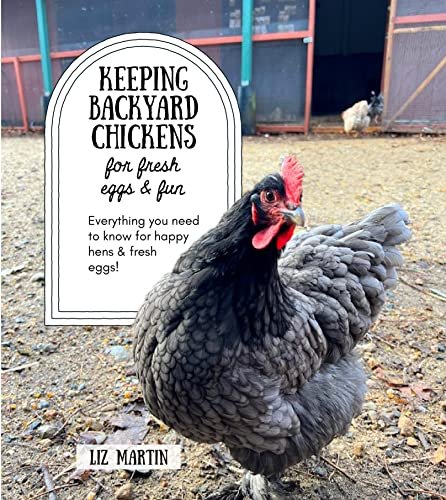


1 Comment
Leave your reply.